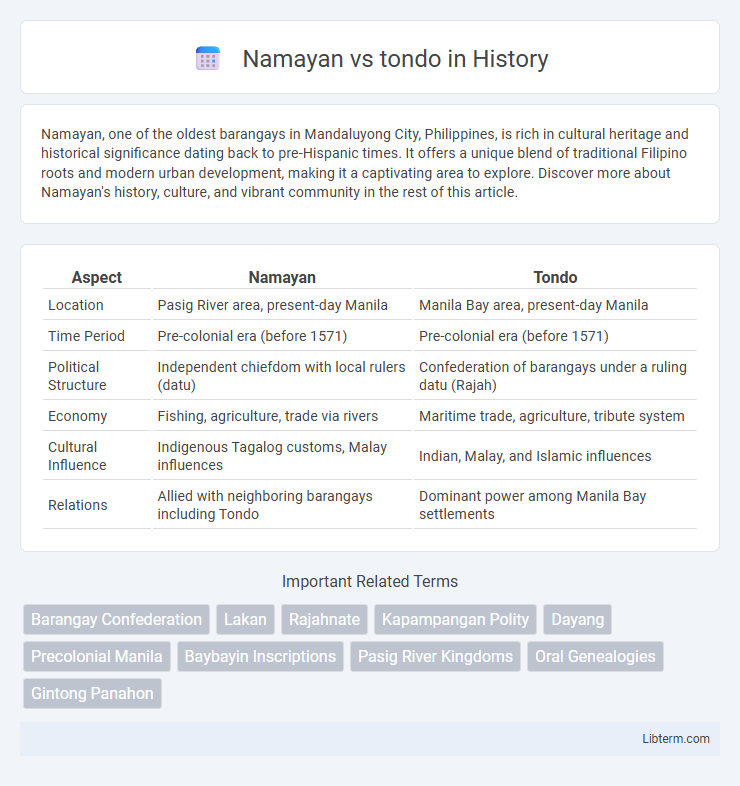Namayan, one of the oldest barangays in Mandaluyong City, Philippines, is rich in cultural heritage and historical significance dating back to pre-Hispanic times. It offers a unique blend of traditional Filipino roots and modern urban development, making it a captivating area to explore. Discover more about Namayan's history, culture, and vibrant community in the rest of this article.
Table of Comparison
| Aspect | Namayan | Tondo |
|---|---|---|
| Location | Pasig River area, present-day Manila | Manila Bay area, present-day Manila |
| Time Period | Pre-colonial era (before 1571) | Pre-colonial era (before 1571) |
| Political Structure | Independent chiefdom with local rulers (datu) | Confederation of barangays under a ruling datu (Rajah) |
| Economy | Fishing, agriculture, trade via rivers | Maritime trade, agriculture, tribute system |
| Cultural Influence | Indigenous Tagalog customs, Malay influences | Indian, Malay, and Islamic influences |
| Relations | Allied with neighboring barangays including Tondo | Dominant power among Manila Bay settlements |
Historical Background of Namayan and Tondo
Namayan, an ancient Philippine polity, was established along the Pasig River and existed from the 13th to 16th centuries, known for its strategic location facilitating trade and agriculture. Tondo, one of the oldest and largest Barangays in Manila, was a dominant political and commercial center in early Luzon, documented as a powerful kingdom interacting with Chinese and other regional traders. Both Namayan and Tondo played crucial roles in pre-colonial Philippine history, with Tondo often regarded as the more influential and expansive entity, while Namayan maintained autonomy over its riverine territories.
Geographic Boundaries and Location
Namayan was located along the Pasig River's southern bank, covering parts of present-day Sta. Ana and Mandaluyong, characterized by fertile riverine plains. Tondo, situated northwest of Namayan, spanned the northern shores of Manila Bay, encompassing modern districts of Tondo and parts of San Nicolas. Both were vital pre-colonial polities strategically positioned for trade, with Namayan's territory more inland and Tondo dominating coastal access.
Political Structure and Governance
The Namayan polity was characterized by a decentralized system with local rulers called "datus" governing smaller barangays, while Tondo featured a more hierarchical political structure dominated by a paramount chief or "lakan" overseeing multiple barangays. Namayan's governance emphasized kinship ties and localized authority, with limited centralized power, contrasting with Tondo's more organized bureaucracy and centralized leadership. Both polities maintained social order through customary laws, but Tondo's political system allowed for greater regional coordination and control over trade and tribute.
Economic Activities and Trade Networks
Namayan, a precolonial polity located along the Pasig River, thrived through intensive riverine trade and specialized craft production, including metalwork and pottery, facilitating exchanges within the Laguna de Bay basin. Tondo, strategically positioned at Manila Bay, emerged as a dominant trading hub with extensive maritime networks linking Southeast Asia, China, and India, allowing for the export of gold, beeswax, and forest products while importing silk and ceramics. The economic activities of Namayan focused on localized artisanal goods and agricultural surplus, whereas Tondo's robust port system supported large-scale international trade and political influence in the region.
Cultural Influences and Practices
Namayan and Tondo both exhibit rich pre-colonial cultural influences rooted in indigenous Malay traditions, yet Namayan is distinguished by its stronger emphasis on ancestor worship and intricate burial customs. Tondo, as a major trade hub, integrated diverse cultural practices through extensive interactions with Chinese, Indian, and Islamic traders, reflected in its syncretic religious rituals and social organization. Artifacts from Namayan reveal more localized pottery and textile techniques, while Tondo's material culture shows broader foreign influences in ceramics and metalwork.
Religion and Belief Systems
Namayan embraced an indigenous animistic belief system centered on nature spirits and ancestral worship, with sacred rituals performed by local babaylans or shamans. Tondo also practiced animism but integrated trade-driven cultural exchanges that introduced Hindu-Buddhist influences, visible in some artifacts and social practices. Both polities revered deities connected to water and agriculture, reflecting their reliance on riverine environments.
Key Historical Figures and Rulers
Namayan was led by Lakan Tagkan and Lakandula, known for their influential roles in early Philippine history, while Tondo was ruled by Lakan Dula, who established significant political and trade alliances. Both polities played critical roles in pre-colonial Luzon, with Namayan's rulers known for their spiritual and administrative leadership and Tondo's leaders recognized for their diplomatic engagements with the Spanish colonizers. These key figures shaped the sociopolitical landscape of Manila Bay before Spanish colonization in the 16th century.
Namayan vs Tondo: Territorial Conflicts
Namayan and Tondo both occupied strategic locations along the Pasig River in pre-colonial Manila, leading to frequent territorial disputes over control of trade routes and fishing grounds. Namayan's domain included parts of modern-day Mandaluyong and Makati, while Tondo's influence extended primarily across present-day Manila and Bulacan, heightening competition. These territorial conflicts shaped early political dynamics, influencing alliances and the distribution of power before Spanish colonization.
Legacy and Impact on Modern Manila
Namayan, one of the earliest known settlements in the Manila area, laid foundational cultural and social structures that influenced the development of surrounding communities including Tondo. Tondo grew into a powerful and densely populated polity, playing a critical role in trade, politics, and resistance against colonial forces, significantly shaping the economic and political landscape of modern Manila. The legacies of Namayan's early governance and Tondo's strategic prominence are embedded in Manila's urban identity, impacting contemporary cultural heritage and city planning.
Comparative Analysis: Namayan and Tondo
Namayan and Tondo were significant pre-colonial polities in the Manila Bay region, with Tondo being larger in territorial extent and political influence during early Philippine history. Namayan, centered around present-day Pasig and Mandaluyong, was a smaller but strategically important settlement known for its trade and cultural exchanges. Tondo's dominance in commerce and alliances with Chinese traders contrasted with Namayan's localized control, highlighting their complementary roles in regional development.
Namayan Infographic

 libterm.com
libterm.com